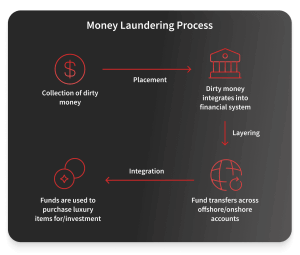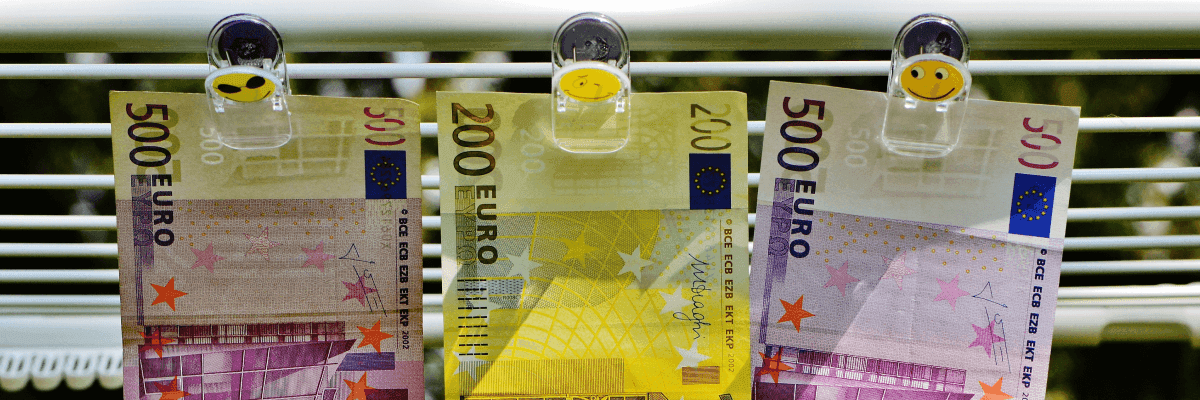Many people have heard the term money laundering at least once in their lives. Cleaning up dirty money is a complex AND illegal process, but what is integration in money laundering?
In this article, we will explain money laundering, its stages, and the illicit ways criminals integrate laundered funds into the system, with devastating consequences for the economy and honest working people.
What is money laundering?
Money laundering is a process of making illegally gained proceeds appear legal by exchanging money or assets obtained criminally for money or other ‘clean’ assets. It is a serious financial crime committed by white-collar and street-level criminals alike.
Many financial companies today have anti-money laundering (AML) policies in place to detect and prevent this activity. Unfortunately, the true extent of money laundering can be challenging to recognize.
Moreover, anti-money laundering authorities are concerned with both the source and destination of the funds, as money laundering can be linked to terrorism financing and serious organized crime.
Consequently, money laundering regulations are strict and regularly updated to combat this illicit practice.
Money laundering process
Money laundering is crucial for criminal organizations aiming to effectively use illegally obtained money. This is because dealing with large amounts of illegal cash directly is inefficient and risky.
To deposit money in legitimate financial institutions without raising suspicions, criminals employ a three-step process: placement, layering, and integration.

During the placement stage, “dirty money” is covertly injected into the legitimate financial system.
In the layering stage, the money’s source is concealed through a series of financial transactions and bookkeeping maneuvers.
The integration stage is the third and final stage of money laundering. In this stage, the now-laundered money is withdrawn from the legitimate account and can be used for the criminals’ intended purposes.
In real-life situations, this money laundering process may not necessarily involve all three stages, and some stages might be combined or repeated multiple times.

What is integration in money laundering?
Integration is the most complex stage of the money laundering process. In this stage, dirty money is cleaned and reintroduced into the legitimate economy while hiding its illicit origins. This makes it difficult to detect due to the sophisticated techniques used by money launderers.
The integration process often involves multiple laundering pathways: property dealing, front companies, fraudulent loans, and false import/export invoices.
Usually, the illicit money gets integrated back into the legitimate financial system through investments in real estate or the sale of assets purchased during the layering phase.
At this point, distinguishing between legal and illegal wealth becomes extremely challenging, making it difficult to catch the criminal without proper documentation as evidence from the previous stages.
Laundered money integration into a legitimate financial system
Integration techniques vary in diversity. They are often influenced by the money launderer’s available resources and risk tolerance. Below are some common methods employed:
- Investment in legal assets
- Use of front companies and legitimate businesses
- Disguising illicit money as legitimate income
Detecting and preventing integration
Detecting and preventing the integration stage presents a challenging endeavor that demands a multifaceted strategy:
- Monitor and report any suspicious financial transactions.
- Follow Anti-Money Laundering (AML) regulations.
- Employ cutting-edge technologies like AI and machine learning to battle against integration.
Cryptocurrencies and the integration stage of the money laundering process
The use of cryptocurrency for dirty money laundering has risen significantly in the criminal underworld.
With the widespread adoption of cryptocurrencies, criminals are employing similar methods used for fiat currency integration to integrate illegal funds:
- Purchasing high-value assets, like real estate, using cryptocurrency.
- Investing in legitimate businesses using cryptocurrency.
- Utilizing online crypto casinos for money laundering purposes.
In all the scenarios mentioned above, money launderers eventually receive fiat currency. For instance they can:
- sell an asset originally purchased with cryptocurrency.
- receive fiat currency dividends from a business investment made using cryptocurrency.
- cash out from crypto casinos and then exchange the proceeds into fiat currency.
The impact of integration on money laundering
We all know that money laundering, particularly its integration stage, is illegal. However, its consequences are more complex than you may think.
Economic consequences
One of the most dangerous effects of integration is the destabilization of financial institutions and the economy as a whole. Money laundered into the financial system can cause inflation, increase economic inequality, and even contribute to financial crises. It can also distort markets and increase the risk of economic bubbles.
Social consequences
Integration in money laundering encourages crime and corruption and undermines trust in public institutions. The result is an increase in criminal activity and a decrease in social stability.
Legal and regulatory consequences
Law enforcement and regulatory agencies are struggling to deal with the integration of dirty money into the financial system. As a result, the problem and its scale can overwhelm legal frameworks. Therefore, combating money laundering, recovering lost assets, and prosecuting criminals become extremely difficult.
FAQ
Examples of integration in money laundering
So, how exactly is money laundering achieved? Well, money launderers employ various methods to integrate illicit cash into the legitimate economy. Let’s explore some of these techniques:
- Real estate investment: Criminals purchase high-value properties using illicit funds and then rent or sell these properties, receiving clean money as payments, effectively integrating the illegal money into the real estate market.
- Business investments: Illegally obtained funds are invested in legitimate businesses, enabling the launderers to receive seemingly legitimate profits, dividends, or salaries, camouflaging the source of the money.
- Casino transactions: Money launderers utilize legal casinos to convert dirty money into chips or winnings, subsequently cashing out with clean money, along with genuine receipts, to legitimize the funds.
- Stock market transactions: Money launderers may use the stock market to integrate their illegal funds. They buy and sell stocks or other financial instruments, transforming their tainted money into seemingly legitimate assets.
- Trade-based money laundering: Criminals exploit legitimate international trade transactions to move illegal funds across borders. By over-invoicing or under-invoicing goods or services, they conceal the movement of illicit funds.
- Cryptocurrency conversions: To obscure the source of their money, criminals convert illegal funds into various cryptocurrencies and then back into fiat currencies, creating a complex money trail that is difficult to trace.
- Shell companies: Money launderers establish shell companies with the appearance of legitimate business activities. Through these companies, they channel illegal funds, creating a façade of legal transactions.
- Luxury goods purchases: Illicit funds are used to purchase high-value luxury items such as jewelry, watches, or art. These items can later be sold to reintegrate the money into the legitimate market.
What is electronic money laundering?
The internet has become a key aspect of change in the criminal world. As a result, crimes committed over the internet today pose a particularly significant challenge to law enforcement.
The use of online banking providers by criminals, the proliferation of anonymous payment services, and mobile peer-to-peer transfers are making it increasingly difficult to trace illicit money transfers.
Even more problematic is the fact that today wire transfers can take place without leaving any trace of the Internet Protocol (IP) address.
On the internet, criminals are laundering money in multiple ways: through auctions, sales, gambling sites, and virtual gaming platforms. Criminals have multiple bank accounts and exchange dirty money for gaming currencies and then for real, untraceable, and seemingly legitimate money.
Criminals similarly use cryptocurrencies. Yes, cryptocurrencies are not that anonymous. However, they also provide criminals with a much-needed relative level of anonymity.
How to prevent money laundering
Because money laundering is happening in secret, determining the exact amount involved is difficult. However, governments around the world have increased their efforts to combat money laundering.
To combat money laundering, numerous decrees, laws, and institutions have been established. One of them is the Financial Action Task Force (FATF), a global organization established by the G-7 three decades ago to tackle money laundering.
Nonetheless, there are also alternative methods for combating money laundering. For example, it is essential to prevent tax evasion at all stages, from production to consumption, and to monitor large financial transfers.
In addition, the media should promote the fight against organized crime and refrain from glorifying mafia personalities. Furthermore, limiting tax-free revenues discourages cartels and decreases the private sector’s underground economy.
Furthermore, by employing AML software, businesses and financial institutions can improve their AML compliance processes and protect themselves from financial crimes.

